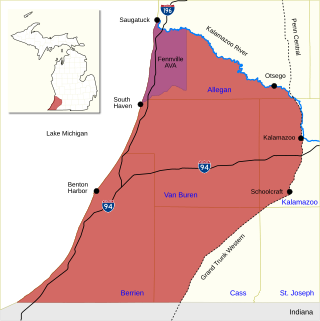The Leelanau Peninsula is a peninsula of the U.S. state of Michigan that extends about 30 miles (50 km) from the western side of the Lower Peninsula of Michigan into Lake Michigan, forming Grand Traverse Bay. It is often referred to as the "little finger" of the mitten-shaped lower peninsula. The peninsula is a tourist hotspot, especially due to the popularity of Sleeping Bear Dunes National Lakeshore, which adorns the southwestern coast of the peninsula. The peninsula is also largely agricultural, and is a production hotspot for cherries and wine.

Lake Michigan Shore AVA is an American Viticultural Area located in southwest Michigan. Located in the state's traditional "fruit belt region", Lake Michigan Shore is the oldest modern commercial grape region of the state and home to a majority of Michigan vineyards and half of the state wine grape production. Vineyards in the region date back to 1867.

Willamette Valley is an American Viticultural Area (AVA) which lies in the Willamette Valley of Oregon. The AVA is the wine growing region which encompasses the drainage basin of the Willamette River. It stretches from the Columbia River in the north to just south of Eugene in the south, where the Willamette Valley ends; and from the Oregon Coast Range in the west to the Cascade Mountains in the east. At 5,360 square miles, it is the largest AVA in the state, and contains most of the state's wineries; approximately 908 as of 2021.

The Niagara Escarpment AVA is an American Viticultural Area in Niagara County, New York along the Niagara Escarpment. Certified by the United States Department of the Treasury's Alcohol and Tobacco Tax and Trade Bureau on October 11, 2005, it covers an area of 18,000 acres (7,284 ha).

The Virginia's Eastern Shore AVA is an American Viticultural Area that includes a 70 miles (113 km) length of Virginia's Eastern Shore and consists of the counties of Accomack and Northampton. The topography in this AVA is mostly level and ranges from sea level to 50 feet (15 m) above sea level. The area is located on the southern end of the Delmarva Peninsula. The weather in the area is characterized by temperate summers and winters, significantly affected by the Chesapeake Bay and the Atlantic Ocean. The soil is sandy and deep.
The Northern Neck George Washington Birthplace AVA is an American Viticultural Area in eastern portion of the state of Virginia. Wines made from grapes grown in Westmoreland, King George, Northumberland, Lancaster, and Richmond counties may use this appellation. The area is located on a peninsula of land between the Potomac and Rappahannock rivers in the Tidewater region of Virginia and known as the Northern Neck. This provides a climate which features more frost free days than the rest of Virginia. The tip of the Northern Neck is located at the Chesapeake Bay. The hardiness zones are 7b and 8a.

The Texas High Plains AVA is an American Viticultural Area located on the Llano Estacado region of Texas. The appellation is the second largest American Viticultural Area in Texas, and covers an area of over 270,000 acres (422 sq mi). Most of the vineyards are on flat terrain at elevations between 3,000 feet (914 m) and 4,000 feet (1,219 m) above sea level. The Texas plains can be extremely dry, so most vineyards are irrigated with water from the Ogallala Aquifer. The hardiness zones are 7a and 7b.
The Mississippi Delta AVA is an American Viticultural Area on the left (east) bank of the Mississippi River, between Memphis, Tennessee, and Vicksburg, Mississippi. It includes portions of the Mississippi Delta and the watershed of the lower Mississippi River in the U.S. states of Louisiana, Mississippi, and Tennessee.
The Ozark Mountain AVA is an American Viticultural Area located in northwest Arkansas, southern Missouri, and northeast Oklahoma. The sixth largest American Viticultural Area in total size, Ozark Mountain AVA covers 3,520,000 acres (1,424,493 ha). Four smaller AVAs have been established within its boundaries, to recognize those distinct regions whose climate, vineyard soil, or other growing conditions create unique areas for viticulture. The hardiness zone in the region varies from 6a to 7b.

The Fennville AVA is an American Viticultural Area located in Allegan County, Michigan. Entirely contained within the larger Lake Michigan Shore AVA, the Fennville AVA borders Lake Michigan on the west, the Kalamazoo River on the north, a game reserve to the east, and the Black River on the south. The soil in the Fennville area is different from surrounding areas, primarily glacial sandy soils. The area's climate is moderated by the nearby Lake Michigan, and few days in the summer growing season exceed 90 °F (32 °C). Grape growers in the area have had success with both Vitis vinifera and Vitis labrusca wine grapes. The hardiness zone is 6a.

The Old Mission Peninsula AVA is an American Viticultural Area located in Grand Traverse County, Michigan known for well-regarded Michigan wine. The Old Mission Peninsula extends northward from Traverse City into the Grand Traverse Bay of Lake Michigan, ending at Old Mission Point. The peninsula is 19 miles (31 km) long by 3 miles (5 km) wide at its widest point. The climate on the peninsula is moderated by the surrounding waters, helping to prevent frost during the growing season. Grape varietals suitable to cool climates, such as Riesling, Chardonnay, Gewürztraminer, Pinot gris, Pinot noir, Cabernet Franc, and Merlot do best in the Old Mission Peninsula AVA.

The Cumberland Valley AVA is an American Viticultural Area located in Washington County in west-central Maryland and Franklin and Cumberland counties in south-central Pennsylvania. Only 100 acres (40 ha) of the 765,000 acres (309,585 ha) included in the wine appellation are planted to grapevines, predominantly on high terraces over the Potomac River and on the slopes of South Mountain. The soil in the area is alkaline limestone. The Cumberland Valley mainly has a hot-summer humid continental climate (Dfa) and is mainly in hardiness zone 7a with 6b in some higher areas. The AVA extends from the Potomac to the Susquehanna River.
The Outer Coastal Plain AVA is an American Viticultural Area located in southeastern New Jersey. The recently expanded 2,250,000 acres (911,000 ha) wine appellation includes all of Cumberland, Cape May, Atlantic, and Ocean counties and portions of Salem, Gloucester, Camden, Burlington, and Monmouth counties. The region is characterized by well-drained sandy or sandy loam soils of low to moderate fertility, and a relatively long growing season. The climate is moderated by the influence of the Atlantic Ocean and Delaware Bay. The region is in hardiness zones 6b, 7a, and 7b. The AVA contains one sub-region, the Cape May Peninsula AVA, which was established in 2018.
The Warren Hills AVA is an American Viticultural Area located in Warren County, New Jersey. The Warren Hills region includes several small valleys formed by tributaries of the Delaware River. The valleys drain from northeast to southwest, and most vineyards in the area are planted on southeast-facing hill slopes. The region is primarily planted with French hybrid grapes. It has a hot-summer humid continental climate (Dfa) and is located in hardiness zones 6b and 7a.
The Western Connecticut Highlands AVA is an American Viticultural Area that includes all of Litchfield and parts of Fairfield, New Haven, and Hartford counties in Connecticut. The Connecticut Highlands are far enough away from Long Island Sound that there is little of the moderating effect on climate that large bodies of water produce. The region is relatively cool, with a short growing season between mid-May and mid-September. The soil in the area is glacial schist and gneiss. Local vintners have had the most success with cool climate Vitis vinifera and French hybrid grape varieties. The region is located in hardiness zones 5b and 6a.
The Southeastern New England AVA is an American Viticultural Area that includes portions of thirteen counties in three New England states: Connecticut, Massachusetts, and Rhode Island. The boundaries of the wine appellation include parts of New Haven, New London, and Middlesex counties in Connecticut; Bristol, Newport, Providence, and Washington counties in Rhode Island; and Barnstable, Bristol, Dukes, Nantucket, Norfolk, and Plymouth counties in Massachusetts. The area stretches from just south of Boston, Massachusetts in the east to New London, Connecticut in the west, and includes all of the coastal islands and coastal plain within 15 miles (24 km) of Long Island Sound, Cape Cod, or Massachusetts Bay.

The Long Island AVA is an American Viticultural Area encompassing Nassau and Suffolk counties of New York, including the smaller offshore islands in those counties. The AVA was established in 2001, over 15 years after two smaller AVAs were created at the eastern end of Long Island. The Long Island AVA designation was promoted as a benefit for some wineries located just outside the two smaller AVAs and for wineries that wanted to create wines that use blends from vineyards in different parts of the island. It was also developed and promoted as a consumer protection of the Long Island name, as AVAs require that at least 85% of the fruit used in the designated wine is grown within the borders of the region. The "Long Island" AVA was authored by veteran Long Island winemaker Richard Olsen-Harbich who also authored "The Hamptons, Long Island" and "North Fork of Long Island" AVAs in the mid-1980s.

The Wisconsin Ledge AVA is an American Viticultural Area in northeast Wisconsin along the Niagara Escarpment in Door, Kewaunee, Manitowoc, Sheboygan, Ozaukee, Washington, Dodge, Fond du Lac, Calumet, Outagamie, and Brown counties. Certified by the United States Department of the Treasury's Alcohol and Tobacco Tax and Trade Bureau on March 22, 2012, it covers an area of 3,800 sq mi (9,800 km2) and is the second AVA designation wholly in Wisconsin, following the Lake Wisconsin AVA established in 1994. The state's third is the gargantuan Upper Mississippi River Valley AVA which also covers land in Minnesota, Iowa and Illinois. After 7 long years, and 4000 hours, Steven J. DeBaker of Trout Springs Winery was granted his petition to the TTB for establishment of the Wisconsin Ledge AVA. It became the 203rd AVA in the US, including just under 2.5 million acres making it the 12th largest AVA in the US. Today, there are 24 bonded wineries that lie within the AVA with over 400 acres of vines planted.
The Middleburg Virginia AVA is an American Viticultural Area in the northern Piedmont region of Virginia, 50 miles (80 km) west of Washington, D.C. It is named for the town of Middleburg, Virginia and is bounded by the Potomac River to the north and by mountains in other directions. The hardiness zone of the AVA is 7a.
The Eastern Connecticut Highlands AVA is an American Viticultural Area established on October 11, 2019, in Connecticut. It is located in Hartford, Middlesex, New Haven, New London, Tolland, and Windham counties. The area is one of rolling hills with elevations of 200 to 1,000 feet. There are pronounced ridgelines to the east and west with higher elevations. The region is relatively cool, with a short growing season between mid-May and mid-September. Its climate is similar to the Finger Lakes region of New York, The soil in the area is composed of glacial till. Local vintners have had the most success with cool climate Vitis vinifera and French hybrid grape varieties. The region is located in hardiness zones 6a to 7a. Sharpe Hill Vineyard in Pomfret is the largest and oldest winery in the AVA. The vineyard petitioned the TTB to lobby for the establishment of the AVA.











